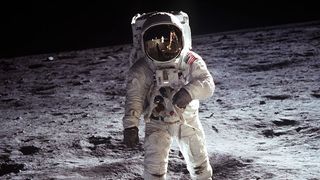
NASA's push to put humans on the moon in 2024 may get a financial boost next year.
A new budget amendment gives NASA an additional $1.6 billion in fiscal year 2020, on top of the $21 billion already allocated to the space agency, President Donald Trump announced today (May 13).
"Under my Administration, we are restoring @NASA to greatness and we are going back to the moon, then Mars. I am updating my budget to include an additional $1.6 billion so that we can return to space in a BIG WAY!" Trump said via Twitter this afternoon.
The amendment is a proposal for now, however; NASA won't get the money until Congress, which has the power of the purse, officially signs off.
The extra $1.6 billion is designed to help NASA put astronauts down near the lunar south pole in 2024, an ambitious goal that Vice President Mike Pence laid out in March. (Prior to Pence's announcement, the agency had been working toward a late-2020s crewed lunar landing.) This pioneering mission will help lead to a long-term, sustainable human presence on the moon, NASA officials have said.
Related: Can NASA Really Put Astronauts on the Moon in 2024?
Under my Administration, we are restoring @NASA to greatness and we are going back to the Moon, then Mars. I am updating my budget to include an additional $1.6 billion so that we can return to Space in a BIG WAY!May 13, 2019
The additional funds would make a big difference, but more cash infusions are still necessary in the future, agency chief Jim Bridenstine said.
Get the Space.com Newsletter
Breaking space news, the latest updates on rocket launches, skywatching events and more!
"This additional investment, I want to be clear, is a down payment on NASA's effort to land humans on the moon by 2024," Bridenstine said during a call with reporters this afternoon. "In the coming years, we will need additional funds, but this is a good amount that gets us out of the gate in a very strong fashion and sets us up for success in the future."
Future cash boosts will need to be higher than $1.6 billion, he added, comparing the funding requirements to a bell curve: Needs will start out low, get higher and higher, and then come back down again.
The $1.6 billion is not coming from anywhere inside NASA, Bridenstine said, stressing that no other agency programs would have to suffer to make the funding boost possible.
NASA still isn't ready to disclose a total cost estimate for the moon-landing effort, which Bridenstine today said is called Artemis. (In Greek mythology, Artemis is the twin sister of Apollo and the goddess of the moon.) But he shot down rumors that the agency is seeking $8 billion per year for the next five years.
"It's nowhere near that much," Bridenstine said.
NASA's plan revolves in part around a small moon-orbiting space station called Gateway, which will serve as a hub for crewed and uncrewed sorties to the lunar surface. Some of these trips will be made by privately built spacecraft; a number of companies, including Jeff Bezos' Blue Origin, are developing landers that could aid NASA's efforts.
And those efforts will not end at the moon. NASA views Earth's nearest neighbor as a stepping-stone and a proving ground where the agency can learn what it needs to do to get people to the ultimate destination — Mars.
You can learn more about the newly announced budget amendment here.
- NASA Plans to Build a Moon-Orbiting Space Station: Here's What You Should Know
- Trump's 2020 NASA Budget Would Cancel Space Telescope, Earth Science Missions (Again)
- Home On the Moon: How to Build a Lunar Colony (Infographic)
Mike Wall's book about the search for alien life, "Out There" (Grand Central Publishing, 2018; illustrated by Karl Tate), is out now. Follow him on Twitter @michaeldwall. Follow us on Twitter @Spacedotcom or Facebook.
Join our Space Forums to keep talking space on the latest missions, night sky and more! And if you have a news tip, correction or comment, let us know at: community@space.com.

Michael Wall is a Senior Space Writer with Space.com and joined the team in 2010. He primarily covers exoplanets, spaceflight and military space, but has been known to dabble in the space art beat. His book about the search for alien life, "Out There," was published on Nov. 13, 2018. Before becoming a science writer, Michael worked as a herpetologist and wildlife biologist. He has a Ph.D. in evolutionary biology from the University of Sydney, Australia, a bachelor's degree from the University of Arizona, and a graduate certificate in science writing from the University of California, Santa Cruz. To find out what his latest project is, you can follow Michael on Twitter.